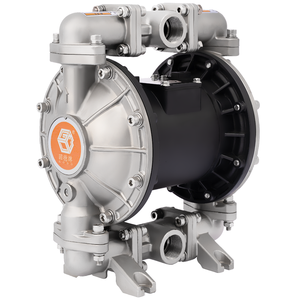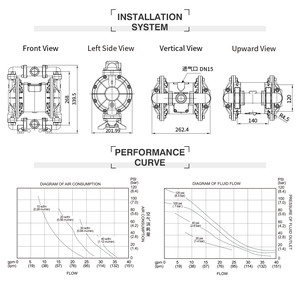
All categories
Featured selections
Trade Assurance
Buyer Central
Help Center
Get the app
Become a supplier

(2964 products available)








































There are differences in wastewater transfer pumps. Each type is suited for particular applications, dependability, efficiency, and ease of use. When choosing a sewage pump, it is better to know the various types available.
A submersible sewage transfer pump operates when submerged in the liquid it moves. They are commonly used in sewage pits. This pump has the advantage of being compact and needing no priming. Its motor is in a sealed casing, which helps prevent damage from the liquid. These pumps can handle solids in the sewage and thus reduce the need for solutions that separate solids from liquids.
Effluent pumps are used to transfer wastewater, partly treated sewage, or effluent from septic systems or treatment plants. They are designed to pump liquid with smaller solids than what submersible sewage pumps can handle.
Also called sewage transfer pumps, they are installed above the water surface. Unlike submersible pumps, surface pumps do not work best when pumping fluid at high levels. For instance, they will pump fluid the flow that is considered moderate to high. These pumps are easier to maintain and install compared to submersible pumps.
Chopper pumps have a chopping mechanism within the pump. The chopper can chop large solids in the sewage so that they can be transferred without causing a blockage. This makes sewage sump pumps ideal for handling sewage with tough solids, fibrous materials, or anything that may cause clogs in the sewage pipes.
Sewage pumps are essential in most industries. They help manage wastewater, improve operations, and have a clean environment.
Construction sites generate a lot of wastewater. This includes water used in construction work and rainwater collected in the areas. Pumps transfer this sewage to the sewage systems or treatment facilities. Without transferring sewage, construction sites would become flooded with wastewater.
Pumped sewage is used in agricultural areas with large farming operations. This is especially common with large dairies and greenhouses. The pumps help manage the wastewater generated by farming activities. They also help mitigate environmental impact and promote sustainability through the reuse of nutrients in wastewater.
Mining operations deal with a lot of water when creating mines. This water can be from groundwater or water used in the mining processes. Sewage pumps help remove this water so mining operations can continue without slowing down due to flooding.
Residential areas that are not close enough to sewer lines use sewage transfer pumps. The pumps help move sewage to the nearest sewer line or treatment facility. This allows people living in hard-to-reach areas to have indoor plumbing and sewage services.
Commercial buildings like hotels, restaurants, and shopping malls generate a lot of wastewater. This includes sewage, kitchen waste, and water used in restrooms. The pumps help manage this wastewater and prevent it from backing up in the building.
Industrial facilities like factories and processing plants generate wastewater. This includes water used in production processes and water from cleaning and maintenance activities. The sewage ejector pump helps manage this wastewater and prevent it from polluting the environment.
Submersible Pumps
A sewage lift pump is designed to operate when fully immersed in the wastewater it pumps. It can easily manage high liquid levels, works well in sewage basins, and needs no priming. As it is submerged, it takes less space and is quieter during operation, making it convenient at construction sites or fuming basements.
Solids Handling Capability
Reliable pumps like the sewage pump can handle solids in wastewater. Most have open or vortex impellers, allowing solids to pass without causing clogs, reducing the need for additional pre-treatment measures.
Strong Motor and Material
These pumps are designed to resist corrosion and wear from harsh wastewater environments. Typically, the materials will be stainless steel, high-density thermoplastics, or cast iron. Also, most have strong motors designed for heavy industrial use, allowing them to run for many hours without overheating.
Automatic Operation
Sewage pumps incorporate float switches that automatically detect liquid levels and turn the pump on and off as required. This ensures automatic pH without needing constant manual checks, which makes the operation quite easy.
Versatile Installation
These pumps can be installed permanently in fixed stations and also temporarily used by contractors for portable applications. This makes the sewage drain field pump quite flexible and useful in various situations, from removing sewage from pits to dewatering construction sites.
Preparation of Site and Selecting Pump
Before starting the installation, the site must be prepared properly, and the right pump for the job must be selected based on the requirements. This includes the flow rate, total dynamic head, and solids-handling capability. The area should be inspected to determine where a pit or basin will be located and how the plumbing will be connected.
Creating a Pump Basin or Pit
This involves constructing a sewage pit or basin made out of either concrete or plastic. The basin will be where the wastewater collects before the pump transfers the sewage. The size of the basin must be able to accommodate the expected volume of sewage and ensure that the pump will be submerged even at low water levels.
Connecting the Plumbing
At this stage, the inlet and outlet pipes will be connected. The inlet pipe brings wastewater from the building or the area generating the sewage. The outlet pipe transfers the pumped sewage to either the sewer line or the nearest the sewage system. The pipes should be sealed properly to prevent any leakage.
Installing the Pump
Once the basin and plumbing are ready, the sewage grinder pump will be installed. The pump will be placed at the bottom of the pit and secured to prevent movement when in use. If it's a submersible pump, it'll be submerged. For surface pumps, the pump will be placed on the surface of the basin.
Electrical Connections
Submersible and automatic pumps are powered by electricity and should be wired according to local electrical codes. It should be ensured that there is no electrical hazard in areas likely to be filled with sewage water. These include explosion-proof outlets and circuit breakers that will prevent the circuit from turning on if it is wet.
Testing the System
Once everything is set up, the system will be tested for proper operation. This will involve filling the basin with water to see if the pump turns on and off as it should. The pump will be monitored to ensure it properly moves sewage without any issues.
Regular Inspections
Regular inspections will help identify potential problems with the pump system. This includes checking for leaks, unusual noises, vibration, or any decrease in performance. The indicators to be on the lookout for are the signs of wear on pump parts or electrical issues.
Clearing Debris
One of the maintenance tasks is clearing any debris from the sewage pit. This prevents clogging and allows the pump to work efficiently. Any solids or sediment that have built up on the pump inlet or inside the basin will need to be removed.
Lubrication of Parts
Lubrication of any moving parts within the pump will be required to ensure that it operates smoothly and for a long time. Most sewage pumps have oil-filled upper bearings that will need to be replaced occasionally. Consult the manufacturer's instructions for lubrication requirements.
Testing Electrical Components
There's a need to check the floats and other electrical components regularly. Ensure they are not faulty and that the pump turns on and off based on the float switch guidance. Any problems with the wiring or electrical connections should be fixed immediately because they can prevent the sewage transfer pump from working.
Monitoring Vibration
A little or no vibration is expected from a well-balanced sewage pump. However, if there is one, the pump will need to be realigned or secured properly. Excess vibration causes wear on the pump and surrounding equipment.
Repairing and Replacing Parts
As the pump gets older, some parts will become worn down and will require repairing or replacing. The impeller, seals, and motor may need to be replaced from time to time so that the pump can operate as a new one. Once the pump is worn out or beyond too many repairs, it will need to be replaced completely.
Materials of Pump
These sewage basin pumps are made from materials that are meant to resist corrosion and wear. They usually come in stainless steel or high-density thermoplastics. This helps in increasing their operating time and reducing failure rates.
Mean time between failure (MTBF)
This is the total time a pump operates until it completely fails, with downtime for repair or replacement taken into consideration. Pumps with longer MTBF are quite desirable in sewage and effluent transfer applications. This reduces maintenance and provides continuous pumping as required.
Energy Efficiency
Sewage pumps are designed to be as energy efficient as possible during sewage pump out. This reduces operating costs over time and can be an important consideration in environmentally responsible businesses. The motor speed is controlled by variable frequency drives (VFD) to help adjust the pump according to the flow required.
Noise Levels
The noise levels will need to be taken into consideration when choosing a pump, especially in areas where quieter operation is necessary. Technologies like submersible pumps or those with anti-vibration features will help reduce the amount of noise that is generated.
Sewage handling
Sewage can contain pathogens that are harmful to health. Pumps will always be sealed correctly, and operators will use protective gear when near the pump to avoid direct contact with sewage.
Electrical safety
Most of the electrical pumps are wired according to local electrical codes. All electrical components are waterproofed to prevent short circuits or electric shock. Any electrical repairs on the pump must be done after the electric power is turned off completely.
Confined space entry
The pits or basins in which sewage pumps are placed are considered confined spaces and come with risks. These include lack of oxygen, hazardous gases, and the possibility of collapse. These pits or basins should be entered only after following the right confined space entry procedures.
Mechanical hazards
Sewage pumps have moving parts that can cause injuries like entanglement or abrasions. The moving parts should be guarded. There should be no access to any moving part when the pump is powered on.
A1: The main purpose of a sewage pump is to transfer wastewater from areas lower than sewer lines to bring it to the required elevation for gravitational flow into the sewage system. They are used in residential, commercial, and industrial applications.
A2: The sewage ejector pump is a type of sewage pump meant for handling sewage with solids included. On the other hand, a sewage transfer pump can be submersible or surface mounted.
A3: Sewage pumps are placed in sewage pits or chambers called subsoil or soil absorption system. The pump is located at the bottom of the pit. When the sewage reaches a defined level, the pump will turn on automatically.
A4:Under normal operating conditions, sewage transfer pumps will average between 5 to 15 years of time. The life duration will depend on factors like pump quality, the amount of sewage put in variabilities, and maintenance done.